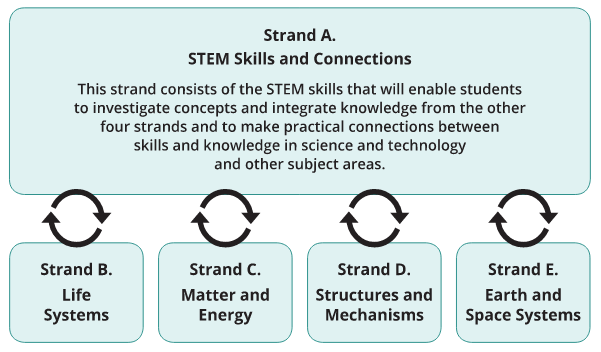Coding in primary science and technology
By: Steven Floyd and Lisa Anne Floyd
In this article, we’ll look at some of the key components related to coding in the grades 1-3 expectations in the new Ontario Science and Technology Curriculum released in 2022.
Grades 1-8 include one overall and two specific expectations related to coding for each grade. In order to provide educators of grades 1-3 with potential insight and direction for implementation in their classroom, we’ve broken down these expectations here.
Overall expectation for grades 1-3
A2. Coding and Emerging Technologies – use coding in investigations and to model concepts, and assess the impact of coding and of emerging technologies on everyday life
| Grade 1 specific expectations: A2.1 write and execute code in investigations and when modelling concepts, with a focus on creating clear and precise instructions for simple algorithms A2.2 identify and describe impacts of coding and of emerging technologies on everyday life | Grade 2 specific expectations: A2.1 write and execute code in investigations and when modelling concepts, with a focus on decomposing problems into smaller steps A2.2 identify and describe impacts of coding and of emerging technologies on everyday life | Grade 3 specific expectations: A2.1 write and execute code in investigations and when modelling concepts, with a focus on testing, debugging, and refining programs A2.2 identify and describe impacts of coding and of emerging technologies on everyday life |
What – What will students be doing?
All expectations related to coding can be found in Strand A -STEM Skills and Connections of The Ontario Curriculum, Grades 1-8: Science and Technology curriculum. Components of this strand are meant to be integrated within the learning of concepts from the other four strands, meaning that coding can be used to enhance, support, or demonstrate the learning within the other strands.

The terms used in expectations A2.2 show that students will be learning about the impact of coding, as well as other technologies. This can be a fascinating area of focus, where students can consider all of the devices and applications in their lives, that are controlled or run with computer programming code.
The terms used in the expectations A2.1 reveal that students will be writing code. This means that students will go beyond defining terms, or learning about code, and will engage in active learning through computing activities.
Expectation A2.1 indicates that students will write and execute code in investigations and when modelling concepts, which is consistent with the approach described above for strand A, as it is being integrated into the learning within the other strands. Students can therefore use coding to investigate concepts related to Life Systems, Matter and Energy, Structures and Mechanisms, or Earth and Space Systems.
How – How will students be doing it?
The curriculum expectations include slightly different coding concepts for each grade, indicating that students will be focusing on a slightly different area of coding, as they complete their projects. This is similar to the grades 1-8 Mathematics curriculum, where students are coding in order to support their learning of mathematics, and where each grade has a slightly different area of focus for coding skills or concepts.
The areas of focus for each grade in the Science and Technology curriculum are listed below:
Grade 1: focus on creating clear and precise instructions for simple algorithms
Students can use a programming environment such as ScratchJr, or a robot such as Dash, Dot, Ozobot, or Bee-Bot to write simple algorithms that accomplish a small task. They can consider how precise their instructions need to be, and how the instructions have to be written in a sequential fashion (connection to grade 1 mathematics coding C3.1 and C3.2). They can connect this learning to other strands, as they consider programming an algorithm to demonstrate the needs of a plant or animal, or daily and seasonal changes.
Grade 2: focus on decomposing problems into smaller steps
Students can use ScratchJr, or a robot such as Dash, Dot, Ozobot, or Bee-Bot to explore how bigger programs, that might at first seem overwhelming, can be broken into small steps. They can connect this learning to other strands, as they consider simple machines and movement in the Structures and Mechanisms strand.
Grade 3: focus on testing, debugging, and refining programs
Students can learn that a program rarely works the first time, and that even professional programmers are always testing, debugging and improving upon their projects. The Scratch Jr programming language, or robots such as Dash, Dot, Ozobot, or Bee-Bot can connect nicely to the Forces and Motion topics in Matter and Energy.
The table below summarizes these activities and includes how the coding expectations connect to other learning, from the the other strands in grades 1 through 3.
| Grade | Programming Task | Coding Focus (A2.1) | Learning from other Strands (B-E) |
| 1 | use ScratchJr, or a robot such as Dash, Dot, Ozobot, or Bee-Bot to write simple algorithms that accomplish a small task, such as demonstrating needs of plants or animals, or navigating on paper diagrams that reveal seasonal changes | creating clear and precise instructions for simple algorithms | needs of living things (B2.2, B2.3, B2.5), daily and seasonal change (E2.2) |
| 2 | use a robot such as Dash, Dot, Ozobot, or Bee-Bot to connect learning to simple machines and movement and to learn about how larger programs need to be broken up into small steps before they are completed | decomposing problems into smaller steps | simple machines and movement (D2.1, D2.2, D2.3, D2.5) |
| 3 | use ScratchJr, or a robot such as Dash, Dot, Ozobot, or Bee-Bot to connect learning to forces and motion and to learn about how programs always need to be tested, debugged and made even better | testing, debugging, and refining programs | forces and motion (C2.2, C2.3) |
There are also articles describing potential applications for Junior and Intermediate to support the Science and Technology curriculum.